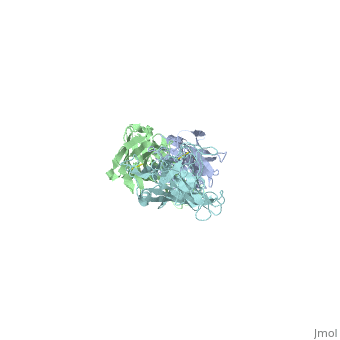OspA
From Proteopedia
(Difference between revisions)
| Line 1: | Line 1: | ||
<applet load='1FJ1' size='500' frame='true' align='right' caption='OSPA.' scene= .'> | <applet load='1FJ1' size='500' frame='true' align='right' caption='OSPA.' scene= .'> | ||
| - | Rapid Prototyping of <scene name='User:Ji_Youn_Park/1fj1_4_24-4/1'>OspA /scene> of Borrelia burgdorferi | + | Rapid Prototyping of <scene name='User:Ji_Youn_Park/1fj1_4_24-4/1'>OspA</scene> of Borrelia burgdorferi |
OspA (Outer surface protein A) is an abundant lipoprotein of the causative agent of Lyme disease, Borrelia burgdorferi spirochete. Its purpose is to stimulate the production of specific antibodies against B. burgdorferi and is used as a vaccination against Lyme disease, the disease carried by ticks(1). | OspA (Outer surface protein A) is an abundant lipoprotein of the causative agent of Lyme disease, Borrelia burgdorferi spirochete. Its purpose is to stimulate the production of specific antibodies against B. burgdorferi and is used as a vaccination against Lyme disease, the disease carried by ticks(1). | ||
It is a borrelial protein that colonizes within the transmitting tick host midgut. Lyme disease is a progressive infection resulting from inoculation of the spirochete Borrelia burgdorferi into the skin by a feeding tick, usually Ixodes species (2); if left untreated; it may progress in many stages beginning from minor symptoms like rash, commonly seen as a bull-eyes rash and then progress into serious, lifelong disabilities. It is known to cause demyelinating diseases in the central nervous system. One of the autoimmune process triggers, resulting in the demyelinating disease, occurs from the endurance of the Borrelia in the host. Once the spirochete is in the Central Nervous System, OspA is up regulated for the sake of adhesion to the area. (6) OspA is up-regulated when the protein is inside the transmitting tick host and begins down regulation upon infection of the mammalian host. Blockage of spirochete transmission from the tick vector to the mammalian host by anti-OspA antibodies appears to be the main mechanism of protection by the immunological response. (3) However, further studies need to be done in order to improve the OspA based vaccines. | It is a borrelial protein that colonizes within the transmitting tick host midgut. Lyme disease is a progressive infection resulting from inoculation of the spirochete Borrelia burgdorferi into the skin by a feeding tick, usually Ixodes species (2); if left untreated; it may progress in many stages beginning from minor symptoms like rash, commonly seen as a bull-eyes rash and then progress into serious, lifelong disabilities. It is known to cause demyelinating diseases in the central nervous system. One of the autoimmune process triggers, resulting in the demyelinating disease, occurs from the endurance of the Borrelia in the host. Once the spirochete is in the Central Nervous System, OspA is up regulated for the sake of adhesion to the area. (6) OspA is up-regulated when the protein is inside the transmitting tick host and begins down regulation upon infection of the mammalian host. Blockage of spirochete transmission from the tick vector to the mammalian host by anti-OspA antibodies appears to be the main mechanism of protection by the immunological response. (3) However, further studies need to be done in order to improve the OspA based vaccines. | ||
Revision as of 18:59, 24 April 2012
| |||||||||||

